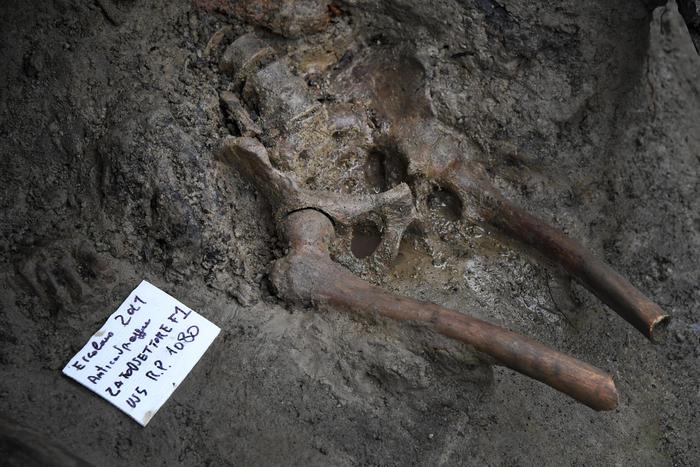(by Silvia Lambertucci)
The partially mutilated skeleton of a man that the avalanche of fire and gas spat out by the erupting Vesuvius stopped a step away from the sea and the mirage of salvation
. 25 years after the last excavations,
a discovery
comes from
Herculaneum
, documented exclusively by ANSA, a discovery that will bring new light on the last moments of life of the town buried like nearby Pompeii by the eruption of 79 AD "A find from which we expect very much ", enthusiastically underlines
the director Francesco Sirano,
since 2017 at the helm of the Archaeological Park, a World Heritage Site. While the Minister of Culture
Franceschini applauds and speaks of a "sensational discovery"
.
The theater is that of the old town beach
, the same place where in the last systematic excavation campaign, conducted in the 80s and 90s of the twentieth century, the remains of more than 300 fugitives who had sought shelter while waiting to be rescued by the fleet of Pliny the Elder. The new excavations, which have engaged the archaeologists of the Park for weeks, are linked to the preparation of a path that will allow visitors to reach the monumental Villa dei Papiri retracing what in the ancient city was the promenade on the seafront and which still remains today. the only completely preserved seafront of a Roman city.
The remains of the man, a mature male who according to the first anthropological tests should have been between 40 and 45 years old,
were found at the base of the very high lava stone wall that today closes the ancient sea front.
He was lying with his head back towards the sea and surrounded by heavy charred driftwood, even the beam of a roof that may have smashed his head.
The bones appear bright red, "it is the imprint left by the victim's blood", says the archaeologist explaining that it is a consequence of the very particular combustion process caused in Herculaneum by the current of magma, ash and gas arrived from Vesuvius .
"The last moments here were instant, but terrible
- underlines - It was one o'clock in the morning, when the pyroclastic flow exploded by the volcano reached the town for the first time with a temperature of 300-400 degrees, indeed, according to some studies even 500-700 degrees. A boiling cloud that ran towards the sea at a speed of 100 kilometers per hour and was so dense that it had no oxygen ". Hell on earth" which in a few minutes swept away and engulfed the highest part of the city, uprooting the roofs and killing men and animals with such heat as to evaporate the bodies ". For the newly found man, an atrocious death, which" must have seen in the face ", who knows, maybe after turning around to look for the reason for that dull roar he heard behind him or because of the light that suddenly must have pierced the darkness of the night, points out thearchaeologist, who now, together with the experts of his team, including the professionals made available by the Packard Humanities Institute (which also donated the project to refurbish the area), questions the identity of this new victim and his role in last hours of the city. Certainly he was not in shelter with all the others waiting crowded into the fishermen's warehouses.
New discovery in Herculaneum, the last fugitive found
"It could be a rescuer, a companion of Pliny's officer
that in the 1980s it had been found about twenty meters away from this point, still on the beach ", hypothesizes. A soldier, therefore, who was perhaps setting up a launch to rescue a first group of people on the high seas. "Or one of the fugitives, who had moved away from the group to reach the sea hoping to be able to embark on one of the lifeboats, who knows perhaps the last and most unfortunate of a group that had managed to take off," he says. At the moment there are many possible hypotheses, including the one that the poor man was on a lookout waiting for the rescue ships, given that Pliny the Younger (grandson of the great admiral and scholar who lost his life in the eruption of 79 AD) tells that the armed quadriremes at the uncle's they had had to give up the landing at the last,stops by a sudden worsening of the situation.
In fact, just to understand something more, the skeleton will now be removed with the help of special metal blades together with a larger portion of the lava rock in which it is embedded and the excavation will continue in the laboratory.
The first in situ examinations, meanwhile, have found traces next to the skeleton of what appear to be fabrics and metals.
"It could be a bag with work tools, but also weapons and coins", Sirano anticipates.
There is a lot of curiosity, also because compared to 25 years ago the investigation techniques and tools have evolved a lot, "Today we have the opportunity to understand more", he explains.
Remained for centuries under a stone wall more than 26 meters high, even the poor fugitive could add new details to the story of that night.

